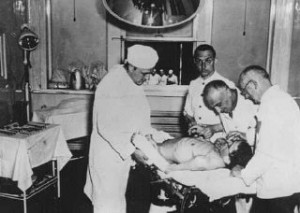In The Medical Profession as a Moral Community, Edmund Pellegrino defines a moral community as “one whose members are bound to each other by a set of commonly held ethical commitments and whose purpose is something other than mere self-interest” (Pellegrino 225). It was extremely interesting to me how he referenced Nazi Germany a couple of times throughout his article in order to establish an understanding of how medicine is a moral community. He mentions how, in Nazi Germany, the vast amount of murders would not have been possible without the cooperation of the physicians (228). The Nazis performed thousands of medical experiments on their concentration camp prisoners that were extremely painful and often deadly. Again, without the cooperation of the physicians, these experiments would not have been “successful” (killing them) and many more people would have survived.
In his article, Pellegrino argues that medicine is basically a moral community because of the numerous aspects of medicine that give it a moral status. According to Pellegrino, there are four aspects of medicine that give it a moral status: the inequality of a medical relationship, the nature of medical decisions, the nature of medical knowledge, and the moral complicity that the physician has over his or her patient. The inequality of a medical relationship refers to when the physician takes care of the patient and does everything in the patient’s best interest. The physician does not think of himself or, for example, the patient’s family members. All of the decisions made are made with the patient’s best interest in mind. The nature of the medical decisions involves proper diagnosis and recommendations that are also done for the patient’s well-being. Moreover, the nature of medical knowledge involves practical knowledge and knowledge that people get through medical education. Pellegrino gave the example of how students in medical school encounter many moral decisions and break moral barriers. Medical school requires students to practice and impose on the privacy of people’s bodies through medical procedures like autopsies. Finally, the moral complicity of the physician refers to the overall responsibility that the physician has for his or her patient. The physician is (or, at least, should be) the one who makes the recommendations for the patient with the patient’s best interest in mind.
Though medicine does have many moral aspects, I would not define it as a moral community like Pellegrino does. He argues that a moral community is independent of what its leaders or members might be at a particular time (225). I think that the Nazi Germany example specifically contradicts this statement because the physicians running the Nazi medical experiments were following orders at a specific point in time. A “moral community” would not perform these kinds of experiments on people if it was truly a moral community. Unless he argues with this example because the Nazis sincerely believed that they were doing something morally correct and had a greater purpose beyond self-interest. So then I pose the question: though a community may be tied together by a set of ethical commitments and does things that have a greater purpose than self-interest, are they really considered a “moral community” if their community involves immoral behaviors like murder?
Works Cited
Pellegrino, Edmund D. “The Medical Profession as a Moral Community” Bulletin of the New York Academy of Medicine 66 (3): 221-232.

